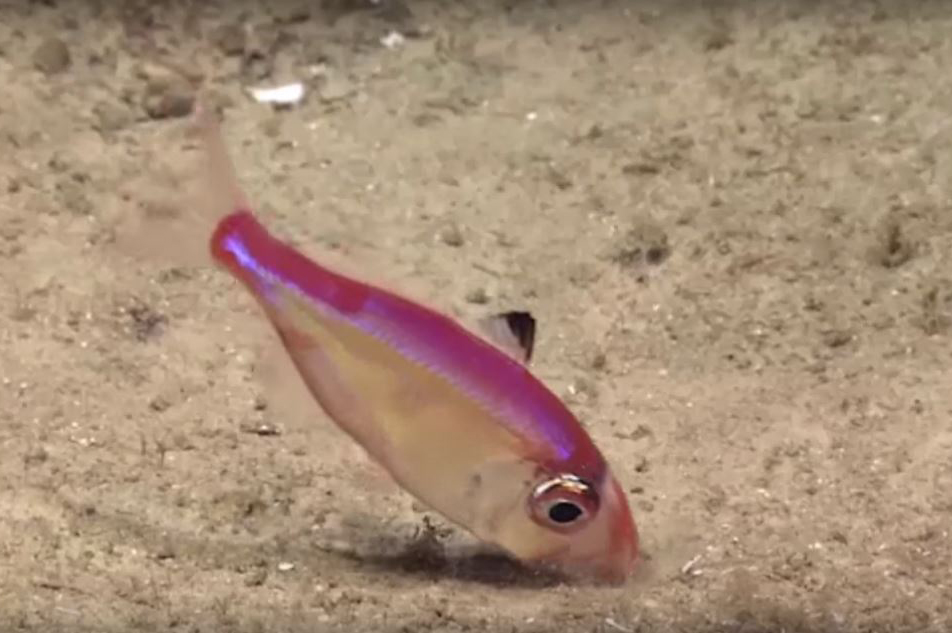- Classification
- ACTINOPTERYGII
- ZEIFORMES
- PARAZENIDAE
- Parazen
- pacificus
Parazen, Parazen pacificus Kamohara 1935

A Parazen, Parazen pacificus, off Puerto Rico in the northeastern Caribbean, April 2015 . Source: NOAA Okeanos Explorer, Océano Profundo 2015: Exploring Puerto Rico’s Seamounts, Trenches, and Troughs. License: CC by Attribution
Summary:
A slender silvery-pink dory with a black blotch on the spinous dorsal fin, a large head, a large eye, a highly protrusible mouth, short weak fin spines, and two lateral lines that converge on the tail base.
Video of a Parazen filmed off Puerto Rico in April 2015 (48 seconds into the video).
Video of a Parazen filmed off Puerto Rico in April 2015 (48 seconds into the video).
Cite this page as:
Bray, D.J. 2017, Parazen pacificus in Fishes of Australia, accessed 02 Jul 2025, https://fishesofaustralia.net.au/Home/species/1487
Parazen, Parazen pacificus Kamohara 1935
More Info
|
Distribution |
West of Shark Bay to northwest of Port Hedland, Western Australia, and off Raine Island, Queensland, to off Eden, New South Wales. Elsewhere the species occurs in the tropical west Indian Ocean, west and east Pacific, west Atlantic. The Parazen is benthopelagic on the continental slope, and is infrequently taken by bottom trawls in Australia. |
|
Features |
Dorsal fin VIII + 26-30; A I (minute), 30-32; Caudal fin 11 (principal rays), 9 (branched rays); Pectoral fin 15-16; Pelvic fin 6-7 (first ray unbranched); Gill rakers 1-2 + 6. Body oblong in shape, compressed; scales absent from head, bones thin, weak; opercular bones weakly serrated; eye large, ~1/3 head length, less than snout length; mouth large, terminal, upper jaw highly protrusible, greatly expanded at rear; jaws with 1-2 rows of small, slender, conical teeth; gill rakers 1-2 + 6. Dorsal-, anal-, and pectoral-fin rays unbranched; dorsal fin spines short, weak; anal-fin spine minute; pectoral fin shorter than eye diameter; caudal fin forked; pelvic fin originating behind pectoral-fin base, first ray unbranched. Scales moderate sized, weakly ctenoid, deciduous, ~90 lateral rows. Two lateral lines originating on body at upper end of operculum, running posteriorly about 4 scale rows apart, gradually converging to form a single line on caudal peduncle. |
|
Feeding |
Taken as bycatch in commercial trawls. |
|
Species Citation |
Parazen pacificus Kamohara 1935, Zool. Mag., Tokyo 47: 245. Type locality: Mimase, Kochi Prefecture, Japan. |
|
Author |
Bray, D.J. 2017 |
|
Resources |
Parazen, Parazen pacificus Kamohara 1935
References
Heemstra, P.C. 1999. Families Parazenidae, Macrocyttidae, Zeidae, Grammicolepididae, Caproidae. pp. 2257-2261 in Carpenter, K.E. & Niem, T.H. (eds) The Living Marine Resources of the Western Central Pacific. FAO Species Identification Guide for Fisheries Purposes. Rome : FAO Vol. 4 pp. 2069-2790.
Hutchins, J.B. 2001. Checklist of the fishes of Western Australia. Records of the Western Australian Museum, Supplement 63: 9-50.
Kamohara, T. 1935. On a new fish of the Zeidae from Kôchi, Japan. Zoological Magazine, Tokyo 47: 245-247 1 fig.
Kotlyar, A.N. 2001. A rare zeid species — Parazen pacificus: osteology, systematics, and distribution (Parazenidae, Zeiformes). Journal of Ichthyology 41(9): 687-697.
Nakabo, T. (ed.) 2002. Fishes of Japan with pictorial keys to the species, English edition. Tokai University Press. v. 1: i-lxi + 1-866
Smith, M.M. & Heemstra, P.C. 1995. Smith's Sea Fishes. Johannesberg : Macmillan South Africa 3rd Impression, i-xxxi + 1047 pp., 144 pls.
Tyler, J.C., O'Toole, B. & Winterbottom, R. 2003. Phylogeny of the genera and families of zeiform fishes, with comments on their relationships with tetraodontiforms and caproids. Smithsonian Contributions to Zoology 618: i-iv, 1-110. PDF Open access






